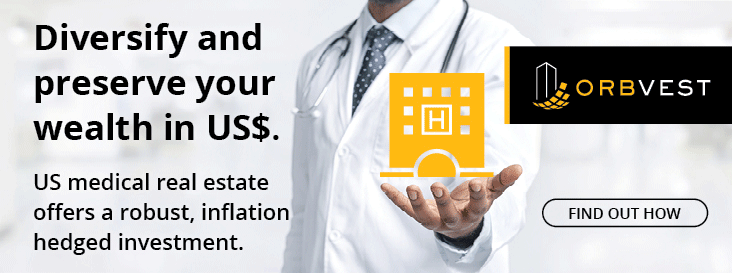At times when global markets are falling, inflation is rising, and there are no clear signals on whether to buy or sell – like now. A diversified portfolio that includes safe-haven assets offshore suddenly looks very appealing.
Diversification is a strategy to reduce the volatility in the returns from your portfolio, while still achieving growth. This is achieved by including different asset classes that are less correlated with equity and fixed interest markets. Examples of such assets, which are often called safe-haven assets, are commercial real estate with long leases or gold. Commercial real estate is regarded as a “safe haven” because they have traditionally retained value, or even appreciate, driven by escalating rentals and the increasing costs of construction when other assets are losing value.
Maybe cryptocurrency looked like a good diversifier because it appeared to exist outside traditional financial systems. What it is showing now is that cryptocurrency is highly correlated with the economic growth outlook – when people are nervous about the future or have geared their crypto and need to pay down debt as interest rates rise, they sell their crypto.
Property is not a uniform asset class
Although a “bricks and mortar” asset will probably lose less value than shares in a market downturn, not all property is the same. Residential property underpinned by floating-rate mortgages and eroding income is vulnerable when interest rates increase, because borrowers may start to default. Investing in a public REIT may be easy but is subject to market sentiment and often trade below the value of the underlying assets.
On the other hand, investing in a commercial building that is fully leased to medical tenants, conservatively geared at a fixed rate, with long-term leases that ensure the tenants are fully responsible for variable costs (called net leases), is less risky.
Medical real estate in the US (depending on how it is structured) is a resilient investment in the property sector because it offers a stable income stream and wealth preservation.
- Medical tenants are reluctant to move, since they often have to install costly equipment in customized offices, so they enter into long-term leases. Consider an imaging centre, a pathology laboratory, or even your dentist, who cannot afford to move premises without significant cost and disruption. That means the property owner can depend on receiving a steady income stream.
- Medical businesses in the US generally have escalation built into their leases, and the services that they provide are not discretionary, which makes them reliable tenants. With a net lease in place, a lot of the costs that tend to rise in inflationary times, such as municipal rates and maintenance, are passed through to the tenants.
Different strokes for different folks
There is obviously more risk in investing in a single building (particularly if it has only one tenant) than in a portfolio of several buildings. For a big-ticket investor, a single building might be the preferred option. You can visit it in person, analyse the pros and cons and keep an eye on how it performs.
If you don’t have the expertise and capital to build your own portfolio of medical commercial real estate, it is better to diversify within this sector to reduce your risk.
For example, OrbVest, the specialist in US medical real estate, has launched OrbVest Diversified Holdings (ODH), which spreads investors’ risk beyond a single tenant/single building. ODH holds shares in all the recent buildings that OrbVest has brought to the market. It’s current offering, ODH 5, contains about 80 tenants spread across more than 20 buildings. OrbVest has made it just as easy as investing in a single building because it still requires a single payment into a company, which is listed on the MERJ exchange in Seychelles. But you can sleep better at night, knowing that even if one tenant defaults for some reason, it has very little impact on your total return.
For South African investors, the minimum investment has been reduced to only $1 000 to allow investors to start small. Returns are paid in dollars, not rands, into your wallet in Seychelles and are completely offshore. The returns are gross of tax, so if you are an SA-resident taxpayer, you need to declare tax on your foreign earnings, as you do with crypto or any other offshore-based asset. While earning a return in dollars, you can pay the tax due in rands and keep your funds offshore.

If you want to find out more about OrbVest and investing in the US medical real estate market, click here to listen to a podcast with OrbVest’s COO, Justin Clarke.
💻 Visit our website to read more about OrbVest.*
*Past performance is no guarantee of future returns
OrbVest SA (Pty) Ltd is a registered FSP with registration Number 50483.



